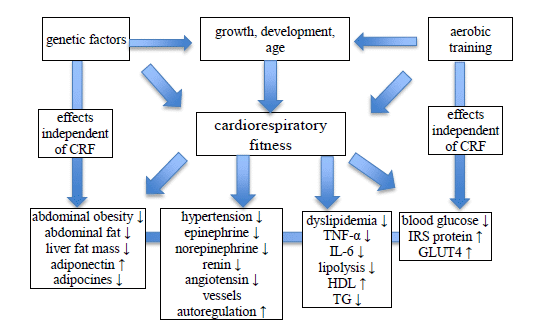XI.2. Physical activity and sport
Regular physical activity enhances the various metabolic processes.
The oxygen uptake is increased. The body breaks down Glu for the energy (ATP) production needed for muscle movements, and may then mobilize the glycogen and finally the fat storages, which depends on the intensity and length of training.
After long-term training, the structure and vascularity of the muscles improves. The increased metabolic demand has an effect on the endocrine system. The circulation and heart function improve. As a result, the load on the body increases.
To determine the degree of fitness, the Cooper test is used most often. In this test, the running distance is measured during 12 min. On the basis of the results, the fitness is categorized: low, medium, good or excellent.
Another method is the determination of the metabolic equivalent (MET). The MET has a value of 1 when the resting oxygen demand is 3.5 ml/kg/min. Office work has a MET of 3, and faster running has a MET of 10.
The measurement of cardiorespiratory fitness gives a more complex picture of fitness. It is measured on a treadmill under medical supervision.
The maximum exercise capacity is determined from:
maximal pulse = 220 - age in years,
50% of the average maximum fitness = 0.5 x (maximum pulse - resting pulse) + resting pulse.
A higher cardiorespiratory fitness value indicates better resistance against various CVDs.
The cardiorespiratory fitness provides information about the transport and use of oxygen and the muscle strength.
A widely accepted consensus definition for categorizing levels of cardiorespiratory fitness does not exist. Various scales are used, because the cardiorespiratory fitness level is influenced by various factors, such as gender, age, nutrition and lifestyle – alcohol and smoking habits, etc.
MET scores < 5 indicate low, 5-10 moderate and > 10 high levels of fitness.
A higher cardiorespiratory fitness value can be achieved by low-intensity physical activity (weekly 5 x 30-40 min walks). Many studies have suggested that a higher cardiorespiratory fitness value may decrease the risk of the development of the MetS.
Only 4 weeks of moderate-intensity aerobic training caused a 21% decrease in the lipid concentration of the liver in obese patients. The liver lipid concentration correlates better with the degree of insulin resistance than with the abdominal fat mass. 10 kg liposuction caused no change in the degree of insulin resistance. The circulating TNF-α and IL-6 levels decreased too.
A 20% increase in cardiorespiratory fitness is accompanied by a 20-30% decrease in the risk of CVDs and a decrease of around 50% in the CVD-caused mortality. These data show that a higher cardiorespiratory fitness decreases the complications of the MetS (circulatory disorders) (Fig. 32).

Figure 32. The effects of CFR on the metabolic cascade elements
(IRS = insulin receptor substrate protein, TG = triglyceride, CRF = cardiorespiratory fitness, TNF-α = tumor necrosis factor alpha, IL-6 = interleukin 6, GLUT-4 = type IV glucose transporter)